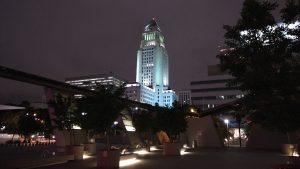Pop quiz: which level of government is responsible for cleaning the air?
Naturally, you might say it’s the federal Government’s responsibility. And you wouldn’t be wrong – after all, the US Environmental Protection Agency is a federal agency and the Clean Air Act is a federal law.
Similarly, you might think clean air is also the responsibility of the California state government. The California Air Resources Board (CARB) is a uniquely powerful state-level agency, and our laws make California a global leader on climate change and environmental protection.
But what about the local level? What can your local governments do to protect your air?
The truth is local governments can do a lot to protect the air. In many ways, the decisions made by our city councils or county boards of supervisors have the most direct impact on our lives and health.
And unfortunately, this presents a problem. Turnout in local government elections is often low. In the November 2018 midterm elections, roughly 48.5% of registered voters in Los Angeles County cast a ballot. Just a little over year before, however, only 17% of LA County voters participated in the March 2017 local elections.
How can local governments improve air quality?
So how exactly can cities and counties help reduce emissions and lessen exposure to pollution? After all, laws and regulations are generally crafted and enforced by the state and federal governments. In addition, cities and counties generally don’t have the budgets to fund expensive incentive programs or large infrastructure investments. Despite these limitations, local governments do have powerful tools at their disposal.
- Land use and city planning: this is perhaps the most important tool local governments have. Land use policies, which include things like zoning and creating “sensitive receptor” buffer zones can limit community exposure to air pollution. For example, until 2018 the City of Los Angeles had few limits on constructing housing near freeways. While Los Angeles still allows for housing to be built near freeways, recently enacted city ordinances require increased pollution mitigation as well as limit the ability to place schools near freeways.
- Permitting and Environmental Impact Reports (EIR): Just as constructing or remodeling a house requires permits from the city, large projects like expanding a railyard or building a freight hub requires permits from local governments. However, prior to issuing permits for a large project, local governments are often required by the California Environmental Quality Act (CEQA) to evaluate the project’s environmental impact and identify mitigation strategies. For example, when the City of Los Angeles approved a permit for the Sunshine Canyon landfill in 2004, they included more than 35 Local Enforcement Agency (LEA) conditions to protect air quality and the environment. In contrast, the City of Moreno Valley conducted a flawed Environmental Impact Report for the World Logistics Center, a proposed 40 million square foot freight hub in the already highly-polluted Inland Empire. Due to a lawsuit (in which CCA was a co-plaintiff), the EIR was invalidated.
- Creating and enforcing city-specific codes and action plans: Local governments can create and enforce local policies to promote clean air. For example, since 2006 the Ports of Long Beach and Los Angeles have maintained the San Pedro Bay Ports Clean Air Action Plan that outlines emission reduction goals and strategies. Similarly, the City of Long Beach is in the process of developing a city-wide Climate Action and Adaptation Plan.
- Appointments to agency boards: In addition to creating policies within their own cities and counties, local elected officials also can create regional and even statewide policy. For example, local elected officials currently serve on the South Coast Air Quality Management District Board (SCAQMD) and CARB. Additionally, Metropolitan Planning Organizations (MPOs) such as the Southern California Association of Governments, are comprised entirely of local governments. MPOs are responsible for addressing regional transportation planning and policy needs. Additionally, MPOs are also partially responsible for implementing 2008’s SB 375 (Steinberg), which seeks to reduce greenhouse gas emissions from passenger vehicles through transportation and land use strategies.
How is CCA working locally
Though CCA’s primary mission is focused on policies and investments that affect California as a whole, we do a considerable amount of local work as well. This includes working with and empowering local advocates, supporting proposed ordinances and actions that will improve air quality, opposing projects that will harm vulnerable communities and worsen the climate crisis, as well as participating in local boards, community meetings and events. For example:
- Freight: In addition to our advocacy at CARB and the state legislature, we’re working to ensure that SCAQMD adopts regulations and agreements that will mitigate impacts from diesel trucks and other vehicles drawn to ports, warehouses and other magnets of pollution. We’re also working on ensuring the ports fulfill their commitments in the Clean Air Action Plan. Lastly, CCA has been a party to successful legal challenges to projects that will degrade air quality, jeopardize public health and worsen climate change.
- Electric vehicle (EV) Deployment: In addition to promoting EV-friendly policies in Sacramento and being part of the effort to defend California’s emissions standards in Washington DC, we also promote EVs locally. Since 2017, we’ve met with 31 elected officials and informed them of the number of EVs in their district purchased through the Clean Vehicle Rebate Project. In addition, we’ve encouraged these local officials to partner with SCAQMD to promote the Replace Your Ride program. Stemming from our advocacy on housing located near freeways, CCA has also worked with the city of Los Angeles to make EV charging infrastructure more accessible.
- Helping guide action plans, community steering committees and other efforts: CCA has actively participated in many workshops and community meetings helping to form the “Our County” plan; Los Angeles County’s first-ever sustainability plan. We’ve also been involved with the local implementation of AB 617, which requires CARB and the regional air districts to identify our most polluted, socioeconomically vulnerable communities and develop emissions reduction plans for them. Specifically, CCA has attended and provided feedback at nearly 20 AB 617 community meetings. I serve as a member of the Wilmington/Carson/West Long Beach steering committee. Lastly, CCA was instrumental in getting local elected officials to support their communities’ nominations for AB 617 implementation.
- Clean Air Day partnerships: This past October 3rd, the Coalition for Clean Air held the first-ever Clean Air Day, which challenged individuals and organizations to act to reduce their carbon emissions. Over 100,000 individuals took the pledge, with over 1 million actions being taken. 40 mayors participated in the Mayors Clean Air Day Council, and 22 local governments observed Clean Air Day. We even worked with Caltrans District 7 (Los Angeles and Ventura Counties) to promote Clean Air Day on traffic information signs across Southern California.
Clean air at home and all of California
There is an old saying in politics – “All politics is local.” And just as in the case of politics, the quality of the air you breathe is local. Advocates and constituents need to engage with all levels of government and stress the importance of cleaning the air. Please take the time to contact your City Councilmember, County Supervisor, School District Board and any other local official and let them know that clean air is important to you.








